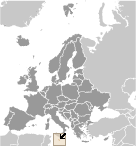World Atlas: Malta. On this page you can see the map, country flag and many detailed information about the people, history and economy of Malta.

Here you can find online selected information about the geography, inhabitants, government, economy and history of Malta. Included are selected statistics, an overview map and the detailed map of Malta. But let's start with the flag of Malta here:
Malta - Overview:
What you should know about Malta? Let's start with this: With a civilization that dates back thousands of years, Malta boasts some of the oldest megalithic sites in the world. Situated in the center of the Mediterranean, Malta’s islands have long served as a strategic military asset, with the islands at various times having come under control of the Phoenicians, Carthaginians, Greeks, Romans,
Geography of Malta
 Where on the globe is Malta? The location of this country is Southern Europe, islands in the Mediterranean Sea, south of Sicily (Italy). Total area of Malta is 316 sq km, of which 316 sq km is land. So this is quite a small country. How could we describe the terrain of the country? This way: mostly low, rocky, flat to dissected plains; many coastal cliffs. The lowest point of Malta is Mediterranean Sea 0 m, the highest point Ta'Dmejrek on Dingli Cliffs 253 m. And the climate is Mediterranean; mild, rainy winters; hot, dry summers.
Where on the globe is Malta? The location of this country is Southern Europe, islands in the Mediterranean Sea, south of Sicily (Italy). Total area of Malta is 316 sq km, of which 316 sq km is land. So this is quite a small country. How could we describe the terrain of the country? This way: mostly low, rocky, flat to dissected plains; many coastal cliffs. The lowest point of Malta is Mediterranean Sea 0 m, the highest point Ta'Dmejrek on Dingli Cliffs 253 m. And the climate is Mediterranean; mild, rainy winters; hot, dry summers.
Inhabitants of Malta
Let's take a look how many people live in Malta. The number is: 416,338 (July 2017 est.). So not so many people live here. Who lives here? Maltese (descendants of ancient Carthaginians and Phoenicians with strong elements of Italian and other Mediterranean stock). What are the languages in Malta? Maltese (official) 90.1%, English (official) 6%, multilingual 3%, other 0.9% (2005 est.). And the religions: Roman Catholic (official) more than 90% (2006 est.). How old are the people in average? 41.8 years. We have to add that this number is the median - so one half of the people is older than this, one half is younger. And what is their life expectancy (at birth)? This: 80.5 years. Where the people live in Malta? Here: most of the population lives on the eastern half of Malta, the largest of the three inhabited islands. The major urban areas of Malta are: Valletta (capital) 197,000 (2014).
Government and Economy of Malta
The capital of Malta is Valletta and the government type parliamentary republic. Let's take a look at the administrative divisions - 68 localities (Il-lokalita); Attard, Balzan, Birgu, Birkirkara, Birzebbuga, Bormla, Dingli, Fgura, Floriana, Fontana, Ghajnsielem, Gharb, Gharghur, Ghasri, Ghaxaq, Gudja, Gzira, Hamrun, Iklin, Imdina, Imgarr, Imqabba, Imsida, Imtarfa, Isla, Kalkara, Kercem, Kirkop, Lija, Luqa, Marsa, Marsaskala, Marsaxlokk, Mellieha, Mosta, Munxar, Nadur, Naxxar, Paola, Pembroke, Pieta, Qala, Qormi, Qrendi, Rabat, Rabat (Ghawdex), Safi, San Giljan/Saint Julian, San Gwann/Saint John, San Lawrenz/Saint Lawrence, Sannat, San Pawl il-Bahar/Saint Paul's Bay, Santa Lucija/Saint Lucia, Santa Venera/Saint Venera, Siggiewi, Sliema, Swieqi, Tarxien, Ta' Xbiex, Valletta, Xaghra, Xewkija, Xghajra, Zabbar, Zebbug, Zebbug (Ghawdex), Zejtun, Zurrieq. Regarding the economy of Malta, important industrial products are tourism, electronics, ship building and repair, construction, food and beverages, pharmaceuticals, footwear, clothing, tobacco, aviation services, financial services, information technology services. Important agricultural products are potatoes, cauliflower, grapes, wheat, barley, tomatoes, citrus, cut flowers, green peppers; pork, milk, poultry, eggs. The most important export commodities are machinery and mechanical appliances; mineral fuels, oils and petroleum products; pharmaceutical products; books and newspapers; aircraft/spacecraft and parts; toys, games, and sports equipment and the most important export partners are US 27.3%, Germany 13.9%, France 8.3%, Singapore 5.6%, Japan 5.2%, Hong Kong 4.3%, Italy 4.2% (2016). The most important import commodities are mineral fuels, oils and products; electrical machinery; aircraft/spacecraft and parts thereof; machinery and mechanical appliances; plastic and other semi-manufactured goods; vehicles and parts and the most important import partners are Italy 20.9%, Canada 10.4%, Germany 6.3%, UK 5.9%, France 4.4% (2016). How rich is Malta and how rich are people in this country? The most important number here is GDP per capita (PPP): $42,500 (2017 est.). This means the people are rich on average here. Let's add that this means Gross Domestic Product per person, which is recalculated with respect to the relative cost of local goods and services. And one more important number - population below poverty line: 16.3% (2015 est.).